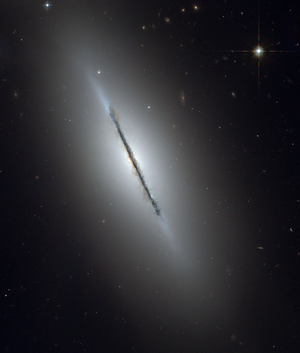- NGC 5866 Group
-
NGC 5866 Group 
NGC 5866, one of the brightest galaxies in the NGC 5866 Group.
Credit: NASA/ESAObservation data (Epoch J2000) Constellation(s) Draco Right ascension 15h 12m[1][2] Declination +56° 26′[1][2] Number of galaxies 3-7[3][1][2] Brightest member NGC 5907[1][2] Other designations NGC 5907 Group, LGG 396[1], NOGG H 836[2],
NOGG P1 841[2], NOGG P2 856[2]See also: Galaxy groups and clusters, List of galaxy clusters
The NGC 5866 Group is a small group of galaxies located in the constellation Draco. The group is named after NGC 5866, the galaxy with the highest apparent magnitude in the group, although some galaxy group catalogs list NGC 5907 as the brightest member.[1][2]Contents
Members
The table below lists galaxies that have been consistently identified as group members in the Nearby Galaxies Catalog[3], the Lyons Groups of Galaxies (LGG) Catalog[1], and the three group lists created from the Nearby Optical Galaxy sample of Giuricin et al.[2].
Members of the NGC 5866 Group Name Type[4] R.A. (J2000)[4] Dec. (J2000)[4] Redshift (km/s)[4] Apparent Magnitude[4] NGC 5866 S0 15h 06m 29.5s +55° 45′ 48″ 672 ± 9 10.7 NGC 5879 SA(rs)bc 15h 09m 46.8s +57° 00′ 01″ 772 ± 5 12.4 NGC 5907 SA(s)c 15h 15m 53.8s +56° 19′ 44″ 667 ± 3 11.1 Other possible members galaxies (galaxies listed in only one or two of the lists from the above references) include NGC 5866B, NGC 5963, UGC 9776, and UGC 9816.
Nearby Groups
The NGC 5866 Group is located to the northwest of both the M101 Group (which contains the Pinwheel Galaxy (M101) and its companion galaxies) and the M51 Group (which contains the Whirlpool Galaxy (M51), the Sunflower Galaxy (M63), and several other galaxies)[5]. The distances to these three groups (as determined from the distances to the individual member galaxies) are similar, which suggests that the M51 Group, the M101 Group, and the NGC 5866 Group are actually part of a large, loose, elongated structure[5]. However, most group identification methods (including those used by the references cited above) identify these three groups as separate entities.
See also
- Leo Triplet - another small group of galaxies
External links
- NGC 5866 Group on WikiSky: DSS2, SDSS, GALEX, IRAS, Hydrogen α, X-Ray, Astrophoto, Sky Map, Articles and images
References
- ^ a b c d e f g A. Garcia (1993). "General study of group membership. II - Determination of nearby groups". Astronomy and Astrophysics Supplement 100: 47–90. Bibcode 1993A&AS..100...47G.
- ^ a b c d e f g h i G. Giuricin, C. Marinoni, L. Ceriani, A. Pisani (2000). "Nearby Optical Galaxies: Selection of the Sample and Identification of Groups". Astrophysical Journal 543 (1): 178–194. Bibcode 2000ApJ...543..178G. doi:10.1086/317070.
- ^ a b R. B. Tully (1988). Nearby Galaxies Catalog. Cambridge: Cambridge University Press. ISBN 0-521-35299-1.
- ^ a b c d e "NASA/IPAC Extragalactic Database". Results for various galaxies. http://nedwww.ipac.caltech.edu/. Retrieved 2006-10-17.
- ^ a b L. Ferrarese, H. C. Ford, J. Huchra, R. C. Kennicutt Jr., J. R. Mould, S. Sakai, W. L. Freedman, P. B. Stetson, B. F. Madore, B. K. Gibson, J. A. Graham, S. M. Hughes, G. D. Illingworth, D. D. Kelson, L. Macri, K. Sebo, N. A. Silbermann (2000). "A Database of Cepheid Distance Moduli and Tip of the Red Giant Branch, Globular Cluster Luminosity Function, Planetary Nebula Luminosity Function, and Surface Brightness Fluctuation Data Useful for Distance Determinations". Astrophysical Journal Supplement 128 (2): 431–459. Bibcode 2000ApJS..128..431F. doi:10.1086/313391.
Categories:- Galaxy clusters
- NGC 5866 Group
- Virgo Supercluster
- Draco constellation
Wikimedia Foundation. 2010.
